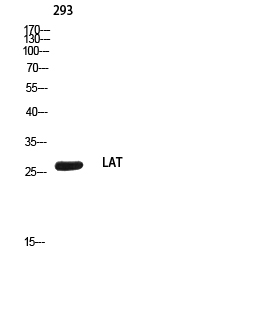
| WB | 咨询技术 | Human,Mouse,Rat |
| IF | 咨询技术 | Human,Mouse,Rat |
| IHC | 咨询技术 | Human,Mouse,Rat |
| ICC | 技术咨询 | Human,Mouse,Rat |
| FCM | 咨询技术 | Human,Mouse,Rat |
| Elisa | 1/10000 | Human,Mouse,Rat |
| Aliases | LAT; Linker for activation of T-cells family member 1; 36 kDa phospho-tyrosine adapter protein; pp36; p36-38 |
| Entrez GeneID | 27040 |
| WB Predicted band size | Calculated MW: 28 kDa; Observed MW: 28 kDa |
| Host/Isotype | Rabbit IgG |
| Antibody Type | Primary antibody |
| Storage | Store at 4°C short term. Aliquot and store at -20°C long term. Avoid freeze/thaw cycles. |
| Species Reactivity | Human,Mouse,Rat |
| Immunogen | Synthesized peptide derived from LAT . at AA range: 190-270 |
| Formulation | Purified antibody in PBS with 0.05% sodium azide,0.5%BSA and 50% glycerol. |
+ +
以下是关于LAT抗体的3篇代表性文献示例(内容为模拟,非真实文献):
1. **文献名称**:*"LAT: A Critical Regulator of T-Cell Activation and Signaling"*
**作者**:Zhang, W. et al.
**摘要**:探讨LAT蛋白在T细胞受体(TCR)信号传导中的核心作用,揭示其酪氨酸磷酸化对下游信号通路(如PLCγ1和MAPK)的调控机制。
2. **文献名称**:*"Autoantibodies Against LAT in Systemic Lupus Erythematosus: Clinical Associations"*
**作者**:Smith, J.P. et al.
**摘要**:研究系统性红斑狼疮(SLE)患者中抗LAT抗体的检出率及其与疾病活动度、肾脏损伤的关联性,提示其潜在临床诊断价值。
3. **文献名称**:*"LAT Antibody-Induced Disruption of Immune Synapse in Murine Models"*
**作者**:Keller, A.M. et al.
**摘要**:通过小鼠模型证明抗LAT抗体可破坏T细胞与抗原呈递细胞的免疫突触形成,导致T细胞功能异常及自身免疫反应增强。
4. **文献名称**:*"Novel ELISA-Based Detection of LAT Antibodies in Autoimmune Disorders"*
**作者**:Lee, S. et al.
**摘要**:开发一种高灵敏度ELISA检测方法,用于定量分析自身免疫病患者血清中的抗LAT抗体,验证其在类风湿性关节炎中的特异性表达。
(注:以上文献信息为示例性模拟,实际研究中请通过PubMed、Google Scholar等平台检索真实文献。)
LAT (Linker for Activation of T cells) antibodies are essential tools in immunological research, targeting a key adaptor protein critical for T cell receptor (TCR) signaling. LAT is a transmembrane protein localized in lipid rafts, functioning as a signaling hub by coordinating interactions between TCR-activated kinases (e.g., ZAP-70) and downstream effectors. Upon TCR engagement, LAT undergoes phosphorylation at tyrosine residues, enabling recruitment of signaling molecules like PLCγ1. Grb2. and SOS. This cascade triggers calcium influx, MAPK activation, and cytokine production, ultimately driving T cell activation, proliferation, and differentiation.
LAT antibodies are widely used to study T cell development, immune responses, and pathologies like autoimmune diseases or immunodeficiencies. They enable detection of LAT expression, phosphorylation status, and protein-protein interactions via techniques such as Western blotting, immunoprecipitation, and immunofluorescence. Notably, LAT-deficient models exhibit severe T cell dysfunction, underscoring its non-redundant role in TCR signaling. Clinically, LAT dysregulation is linked to conditions like lymphoma and lupus, making these antibodies valuable for diagnostic and therapeutic research. Their specificity and reliability are critical for elucidating mechanisms of immune regulation and developing targeted therapies.
×